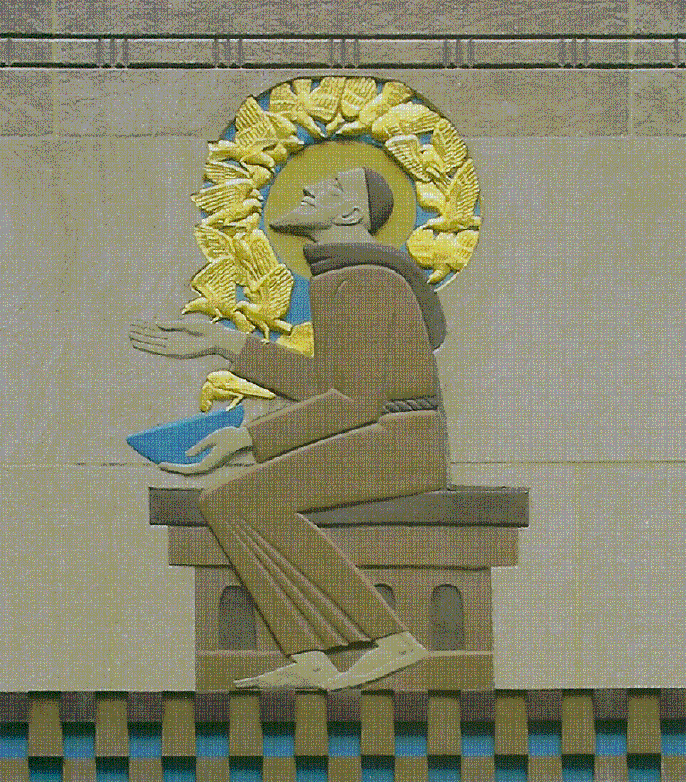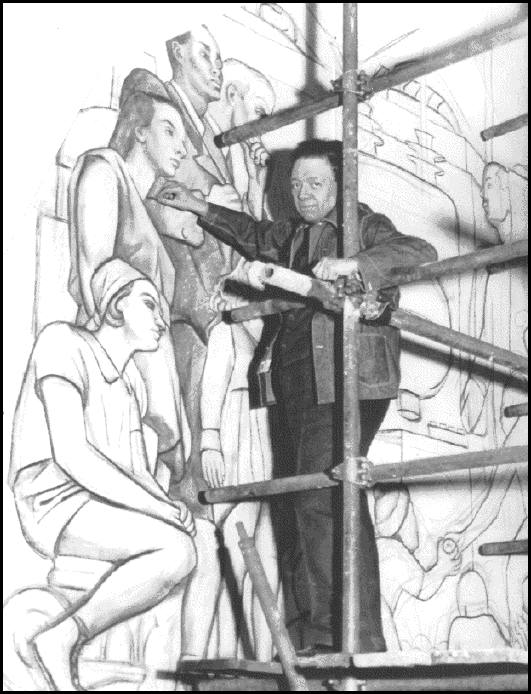
The Art of
Rockefeller
Center
Christine Roussel
(Norton)

It all started in 1928 with John D. Rockefeller, Jr., twenty-two acres in the middle of Manhattan, and a plan to turn those acres into twelve unified buildings. The construction would utilize the services of four architectural firms and thirty-nine artists creating decorative design and color ... from murals and statues down to carpets, mirrors, wall hangings, and elevator doors.The artistic themes were drawn up by a professor of philosophy at Scripps College, Dr. Hartley Burr Alexander. They embodied the likes of "The March of Civilization," "Man's Progress in Industry and the Character of the Nation," and --- one to be stolen latter by JFK --- "New Frontiers." Since all of these are pretty silly, we can dispense with them at once.
Some of the resultant art was pretty silly too. Four stone carvings on the International Building by Leo Lentelli look to be something the cat brought up after breakfast, especially a bull with hand-grenades fastened to each ear which the artist said represented "The Americas."
Some of the art-work --- and some not so easy to see from street level --- has turned out to be delightful. Lee Lawrie was one of the principal artists involved. Twelve of his great bas-reliefs and intaglios were completed between 1933 and 1937, including the carved limestone panel of St. Francis of Assisi [See Fig. 1 above] over the entrance to the International Building.
There was something of a to-do with a fresco by Diego Rivera. Rivera was offered a wall and $21,000 for "Man at the crossroads" who "looks uncertainly but hopefully towards the future." He was hired on in 1933 by Abby Rockefeller, despite the fact that just a few months before he had raised the ire of the respectable families of Detroit when he stuck the Holy Family in the middle of a panel named "Vaccination," though god knows what the mother and father of the divine --- complete with horse and cow --- would be doing in the city clinic getting our Holy Babe inoculated against small pox and diphtheria.
Rivera was given a large wall in the Grand Lobby at 30 Rockefeller Plaza --- sixty-three feet wide, seventeen feet high --- and promptly sketched in faces around a large centrifuge under what appears to be the engine (with propeller) of a DC3. What was not acceptable was the visage of Nikolai Lenin off there to the right holding hands with several auto workers, though presumably the hand-hold was a sign of mere solidarity, not affection.
Three weeks into the project Rivera was given his walking papers, his fresco was papered over and within a year it was painted over (being named "The Wailing Wall" by the architects who were entreated to come up with something a little less sprightly.) Rivera got his revenge by hurrying back to Mexico City and painting a fresco at El Prado with Trotsky, Marx, and Rockefeller in an awkward dance.
In a photograph taken at the time, the artist looks like the cat that ate the canary [See Fig 3 below] but the sketches left behind suggest that the cover-up was no great loss. Rivera and his contemporaries from Mexico were not given to subtlety in any form. The hideous replacement fresco by José María Sert does make one wish that Rivera had simply surrendered and stuck a fright mask on Lenin so that the original would be there to this day. We might suggest that the current owners of Rockefeller Center find an energetic youngster just out of the Rhode Island School of Design who could study the photographs and "cartoons" from Rivera's fresco and simply paint it back entire over María Sert's abortion. In place of Lenin's face (which would but evoke a yawn nowadays) he could paint in a portrait of someone more dreadful. Donald Rumsfeld, perhaps.
§ § § This is a fine volume. There are over 200 photographs of the art ... along with works in progress and photographs of the creators at work. Some of the later sculptures, especially those of Michio Ihara and Isamu Noguchi make you wish the Rockefellers and their heirs and assigns had stopped while they were ahead, but the color photographs --- plus the black-and-white shots of the original process of creation --- make this collection a dream. And for this critic, the discovery of Lee Lawrie's fragrant blend of color, form, and contrast make it all worth it, with or without that pesky Lenin.

--- Lolita Lark